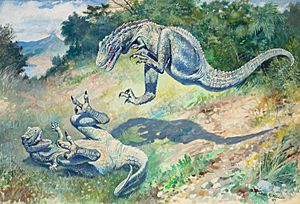Dinosaur renaissance facts for kids
The Dinosaur Renaissance is a name given to a big change in how we think about dinosaurs. It started in the 1970s and is still going on today. Robert Bakker, a scientist, first used this term in 1975. This "renaissance" (which means "rebirth") happened because many new dinosaur fossils were found. Also, scientists came up with exciting new ideas about how dinosaurs lived.
Before this time, people often thought of dinosaurs as slow, clumsy, and cold-blooded reptiles. But new discoveries changed this idea completely. A very important discovery was the Deinonychus fossil in 1964 by John Ostrom. Deinonychus was a fast and fierce hunter. It used a large, sharp claw on its foot to attack its prey. Its tail had strong tendons that made it stiff. This helped the dinosaur balance when it ran and jumped.
This discovery made scientists wonder if some dinosaurs were actually warm-blooded and very active. Robert Bakker, who was a student of John Ostrom, helped spread these new ideas. The old image of dinosaurs as slow, cold-blooded, and not very smart needed to be updated, especially for meat-eating dinosaurs.
Contents
New Ideas About Dinosaurs
The Dinosaur Renaissance brought many new ideas to light. Here are some of the main points:
Are Dinosaurs a Group?
Scientists now agree that all dinosaurs belong to one natural group. This means they all share a common ancestor.
Warm-Blooded or Cold-Blooded?
One of the biggest debates was whether dinosaurs were warm-blooded or cold-blooded. Robert Bakker argued that dinosaurs were active animals with high metabolisms, meaning they could keep their bodies warm from the inside, like mammals and birds. This idea was debated a lot. Today, many scientists believe that dinosaurs had higher metabolic rates than modern reptiles. It's also likely that different types of dinosaurs had different body temperatures. The discovery of feathers on many smaller meat-eating dinosaurs (called theropods) strongly supports the idea that they were warm-blooded.
How Did Dinosaurs Behave?
New fossil finds showed that dinosaurs had interesting social lives.
- Fossil tracks suggest that large plant-eating dinosaurs, like sauropods, moved in groups or herds. Sometimes, the adult dinosaurs would form a circle around the younger ones to protect them.
- Studies of dinosaur nests, like those of the duck-billed dinosaur Maiasaura, showed that these dinosaurs cared for their young. They might have even brought food to their babies in the nest.
How Did Dinosaurs Move?
The Dinosaur Renaissance completely changed how artists drew dinosaurs. Robert Bakker's drawing of Deinonychus is a famous example of how dinosaurs were now shown as active and dynamic. We now know that many two-legged dinosaurs moved with their bodies held almost horizontal. Their long, often heavy tails helped them balance over their hips. These tails were kept stiff by strong tendons running along the vertebrae (backbones). In many adult dinosaurs, these tail tendons even turned partly into bone, making the tail very rigid.
Why Did Dinosaurs Disappear?
For a long time, people thought dinosaurs died out because they were not as good as mammals. But new theories emerged:
- Scientists found a rare metal called Iridium in a layer of rock from the time dinosaurs disappeared. Iridium is mostly found in meteorites.
- Later, a huge impact crater, the Chicxulub crater, was found in Mexico. This suggested that a giant meteor hitting Earth caused the extinction.
- Also, huge volcanic eruptions, known as the Deccan Traps, happened around the same time. These eruptions released massive amounts of gas and dust into the air.
It is now thought that both the meteor impact and the volcanic activity played a role in the extinction event.
Dinosaurs in Pop Culture
The Dinosaur Renaissance made people excited about dinosaurs again. Many new books, movies, and TV shows about dinosaurs were created. The movie Jurassic Park is a great example of how popular dinosaurs became.
Amazing Discoveries in China
The discovery of many new feathered dinosaurs in China has kept dinosaurs at the forefront of science and public interest. These amazing fossils were found in rock layers from the Lower Cretaceous period in the Liaoning province of northeastern China. The animals found there are known as the Jehol biota. These discoveries have given us a much clearer picture of how birds evolved from dinosaurs.
Images for kids
-
Robert Bakker lecturing at the Houston Museum of Natural Science
See also
 In Spanish: Renacimiento de los dinosaurios para niños
In Spanish: Renacimiento de los dinosaurios para niños



